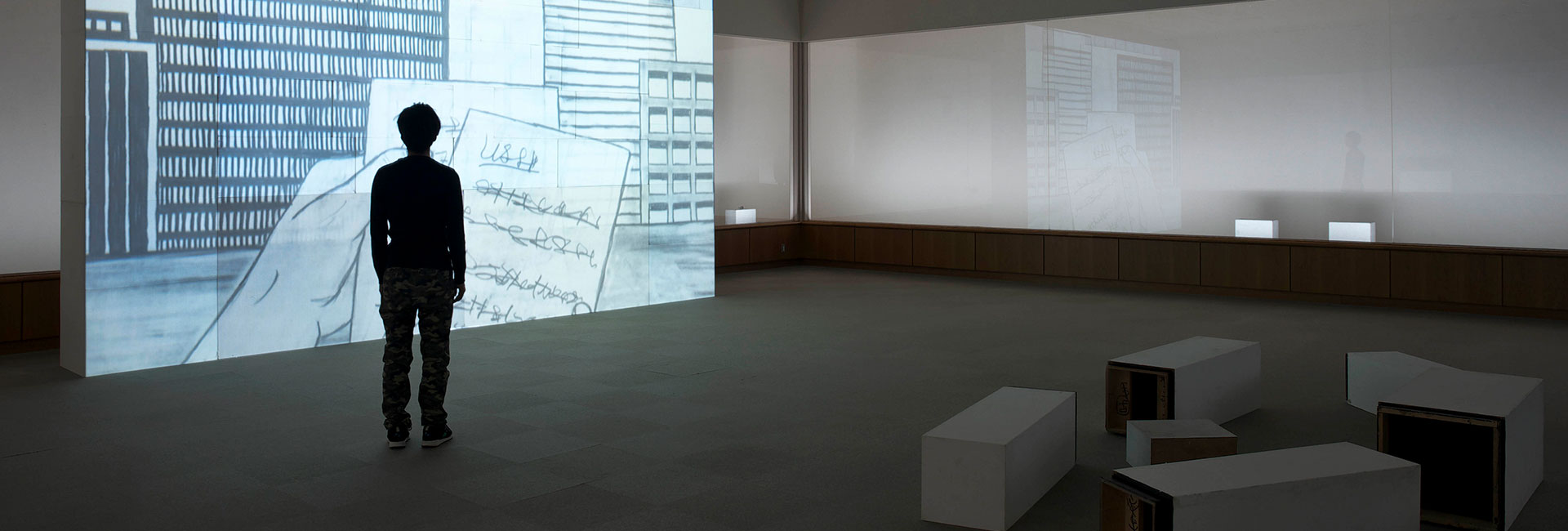Daisuke Nagaoka | Biografia
De Yamagata, vive e trabalha em Tóquio, 1973.
Artista japonês, Mestre em Artes, com ênfase em desenho e pintura, pela Escola de Arte de Wimbledon, em 2003, em Londres. Realizou a mostra individual Another Hole, na Gallery Tokio (2015, Japão) e a exposição individual New Cities, em Hokkaido, em 2013. Participou do Festival Imageforum (2015, Japão) e do Festival Internacional de Filme em Roterdã (2012, Holanda). Foi artista residente do programa Artist in Yobari, (2013, Japão) e do programa de residências do Ateliê Fidalga (2017, Brasil).
The sphere House
A house of sphere. All the functions, that a house holds, are installed in the wall of the spherical surface. Tables and chairs, a bed, a bookshelf and a cupboard are all set up on the surface of the spherical wall, so that they will not fall. If one lives in it and go about doing their day to day mundane things, with each and every action made, the house slants and rolls. If, for example, one stays in the sphere house for 3 days, the house at least rolls one cycle a day. Consequently, a 3-day stay would one experience at least 3 cycles of the house rolling.
Supposedly, the diameter of the house is 3 meteres. The house moves/rolls in a random order, approximately 30m away from where it had originally been. This would change every aspect of how we live. For instance, to purchase a land in order to build a house would become meaningless. Thus, a fixed address is no longer necessary. Along with these changes, the concept of borderline or a borderline between countries will gradually blur. If these are the case, the idea of a country or even a local authority would change. The method of the redistribution of the wealth based on the politics, needless to say, will also change.
The way we work will also be modified accordingly. A notion of a steady job, a fixed job will be replaced. There would be a possibility to build a day-by-day community and to form co-working system so that a labor redistribution within the ever-changing unit of communities can occur. Living situations change and ownership or a possession will be restricted to minimality taking into the consideration of the fact that the house rolls and slants. In these circumstances, we would start to search for the things that are truly significant to us. The economic model that is centered around the notion of individual consumption would shift into a form of co-ownership. Hereby, a change in a numismatic worth would happen. Perhaps, a society without money may even be possible.
Adjustment or a transformation in our somesthesia will occur in a house of sphere. To live in such format together with other members require an understanding and allowance of the movements made by the others. Consequently, it can be expected that communications and relationships with the other will naturally change. Ways of being for a painting would also differ. If they were to be hanging on the wall, they too, need to roll and slant as the house moves. It may perhaps be required that paintings should be in a form that can be viewed up side down. This means that there may be a possibility for reinterpretation of an abstract expressionism. In this way, everything under the sun will transform by living in a house of sphere. Together with the lines and trails that the sphere house leaves behind on the earth, new values will arise and diverse ways of forming a society will be born.
Para conhecer outros trabalhos de Daisuke Nagaoka, acesse aqui
Para ver os vídeos de Daisuke Nagaoka, acesse aqui
Para visualizar as obras de Daisuke Nagaoka na galeria Arte ConTexto, clique aqui.
Revista Arte ConTexto
- REFLEXÃO EM ARTE
ISSN 2318-5538
V.5, Nº13, JUL., ANO 2017
DEIXA O TEXTO MANCHAR

